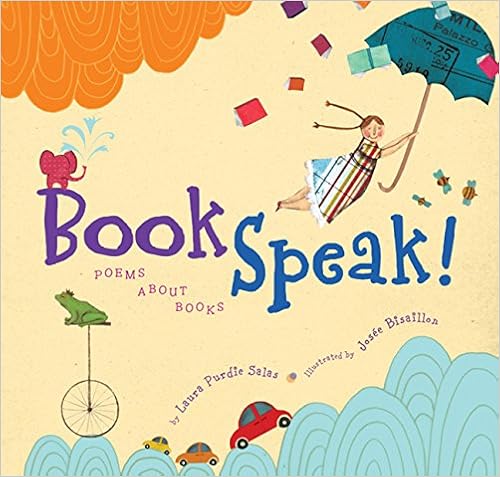Module 3 Book Review #1: BookSpeak!: Poems About Books
*This book review was written for a MLS course at SHSU.*

BIBLIOGRAPHY
Salas, Laura Purdie. (2011). BOOKSPEAK!: POEMS ABOUT BOOKS.
Ill. by Josée Bisaillon.
New York, NY: Clarion Books. ISBN 9780547223001
PLOT SUMMARY
Laura Purdie Salas’s creative
poetry collection is about books and how they use their “voices” to appeal to
readers. In addition to this, the poems represent different literary elements
and how books need them in order to completely fulfill their purpose in life.
As time goes in life, readers need to be reminded about the endless
possibilities that books can provide for them, if they only give the books a
chance.
CRITICAL ANALYSIS
In BookSpeak!: Poems
About Books, Laura Purdie Salas uses a heavy amount of personification in
order to help make the books’ “voices” and literary elements more attractive,
especially when they attempt to persuade individuals to pick them up and read
them. For example, in “Conflicted”, Salas writes, “My characters hate me./They
don’t think I’m grand./But without me/ their plots would be dreary/and bland.”
Conflict, which is a necessary element in stories, describes itself as an enemy
that books need, and readers get to help solve them if they participate in
reading adventures. Other poetic elements that are visible in this collection
of poems include strong imagery and rhyme. Readers can possibly start imagining
the books as living things, and because of the rhyme, have fun reciting book
characteristics as they read.
In addition to the poet trying to reveal the magic of books,
Salas also displayed emotional persuasive elements in her writing in order to
get readers to understand that books are “lonely”. For example, in “On the
Shelf and Under the Bed”, the verse “unread/unshared,/unloved” represents how most
people have forgotten about books because of the progressed society we live in
today. Also, readers can infer that books want to be handled with care. In
“Hydrophobic”, a book discusses that it doesn’t want to get wet, for it feels
that some of its beauty fades away with it.
As for Josée
Bisaillon’s illustrations, they represent a world filled with imagination. The
pictures fit perfectly with each poem’s message. Most of the colors are bright,
which depicts the joy from the books. Pieces of text are also transformed into
pictures (i.e. the trench coat on the “Index” page). Lots of metaphors are
magically brought to life. An example of this is the white page with gray spots
on “Written in Snow”. Bisaillon’s artistry is supposed to represent a blank
page with ink sprawled on it, in which readers can figure out the spots are
really “words” being written and telling a story. Finally, Bisaillon attempted
to connect with today’s readers, especially in “The Middle Lament: A Poem for
Three Voices”. She drew little text message bubbles, which is engaging for
readers to follow when understanding the story’s “feelings”.
REVIEW EXCERPTS
*School Library
Journal Review: "Well-crafted and
clever, covering a variety of aspects of books and reading...An appealing
offering that will be especially popular with librarians."
*Booklist Review:
“With its mix of poetic forms and wry twists on
language-arts terms, this is a natural choice for sharing in classrooms and
young writers’ workshops.”
*Publishers Weekly Review: “Bisaillon’s
mixed media illustrations are dizzyingly inventive, their bright colors,
sampling of typography, and whimsical details underscoring the idea of the
potential that awaits between the covers.”
CONNECTIONS
*I Am the Book by
Lee Bennett Hopkins is another wonderful poetry book that highlights the beauty
of literature and reading. These two books can be read around the same time and
be used as part of a compare and contrast activity during a poetry unit.
*ELAR teachers can create many mini-lessons with this book
with other genres besides poetry. For example, “Index” can be read and
discussed about when students learn about text features. Another example could
be “The Middle’s Lament: A Poem for Three Voices” can be used when
reading/analyzing fiction or when writing a personal narrative, for it
highlights the fact that every story needs a beginning, middle, and an end.
PICTURE SOURCE
https://www.amazon.com/BookSpeak-Poems-Laura-Purdie-Salas/dp/0547223005/ref=sr_1_1?s=books&ie=UTF8&qid=1538580298&sr=1-1&keywords=bookspeak%21
Comments
Post a Comment